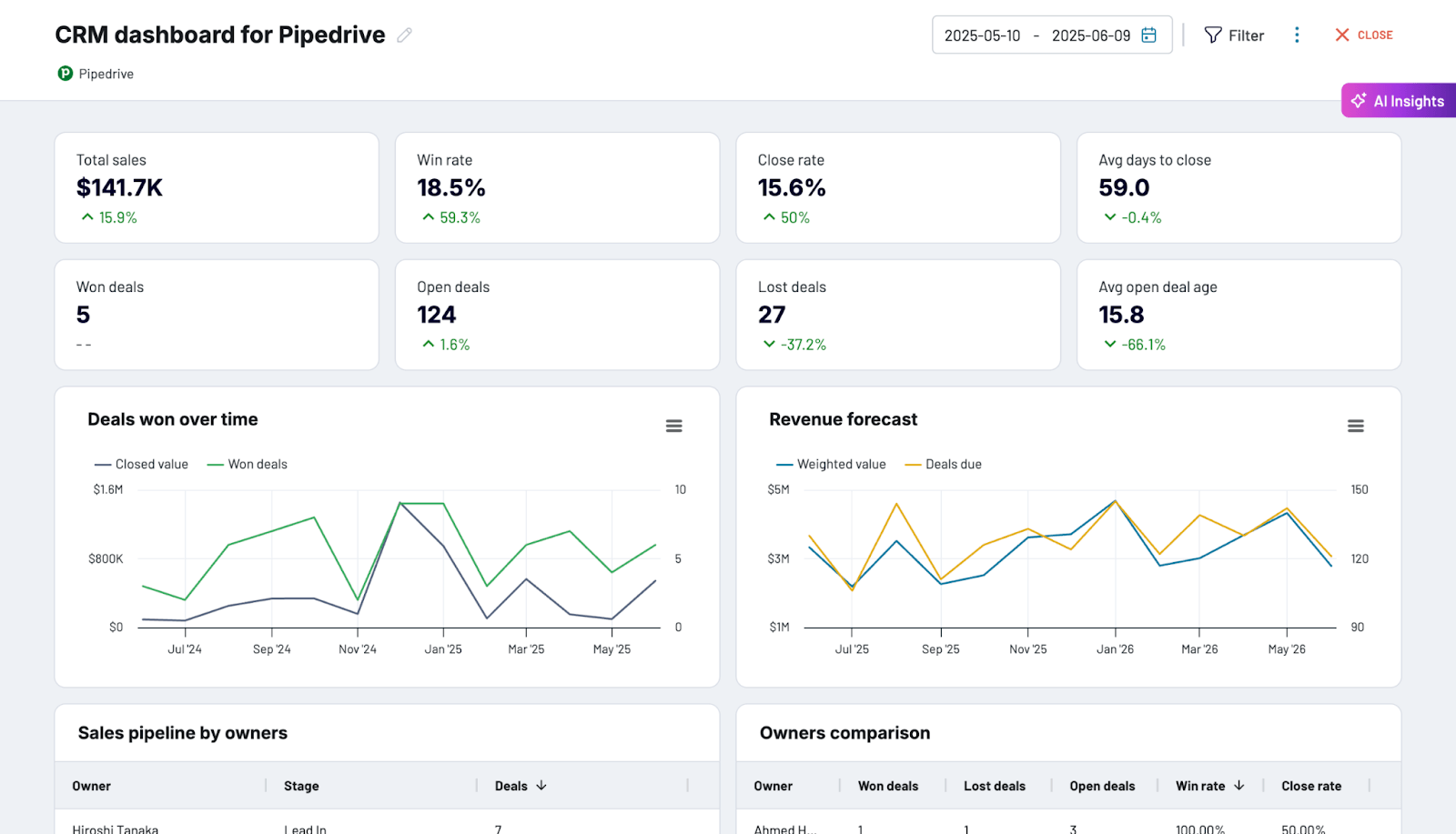What are AI-driven sales insights?
AI-driven sales insights are actionable recommendations generated by artificial intelligence through the analysis of sales data, customer behavior, and engagement patterns. Based on CRM records, customer interactions, purchase histories, market signals, etc., they reveal trends and opportunities that sales teams often miss.
Using these sales insights, you can:
- Identify prospects most likely to convert and prioritize high-potential leads.
- Determine which tactics drive the best results to optimize sales strategies.
- Develop tailored messages, offers, and timing to personalize customer interactions.
- Stay ahead of market shifts and customer needs to predict sales trends and risks.
Businesses that harness AI reporting consistently outperform those relying on intuition alone because they make smarter, data-backed decisions. See how you can start generating these insights yourself to accelerate growth while building relationships with customers.
How you can turn sales data into AI-driven insights with Coupler.io
To gain AI-driven sales insights, you first need to load your data into an AI tool such as ChatGPT or Claude. The challenge is that it’s time-consuming to bring everything into your AI tool manually. Another thing is that your sales data often lives across multiple sources.
A solution is to use Coupler.io, which lets you create reports on your sales data from different sources and supports AI tools as destinations. This way, you can pull your sales data from HubSpot, Salesforce, Pipedrive, ActiveCampaign, GoHighLevel, and others into ChatGPT or Claude and interact with it directly in the AI chat.
With only one tool, you obtain:
- Access to over 200 business data sources to integrate with AI for conversational analytics
- 100+ organized data set templates to make your data analysis-ready
- Load data to AI tools and other data destinations, including spreadsheet apps, BI tools, and data warehouses
- Over 150 plug-n-play dashboard templates
- Automated data refresh with custom scheduling up to every 15 minutes
Let’s now take a look at how sales insights from AI agents work in the example of the HubSpot data analysis. To integrate data from HubSpot with an AI tool, e.g., ChatGPT, you only need to take three steps:
Step 1. Create a data flow
Create a data flow to get information about deals, companies, and line items from HubSpot. You can make it from scratch or use a data set template with preconfigured data transformations, like data entities combined.
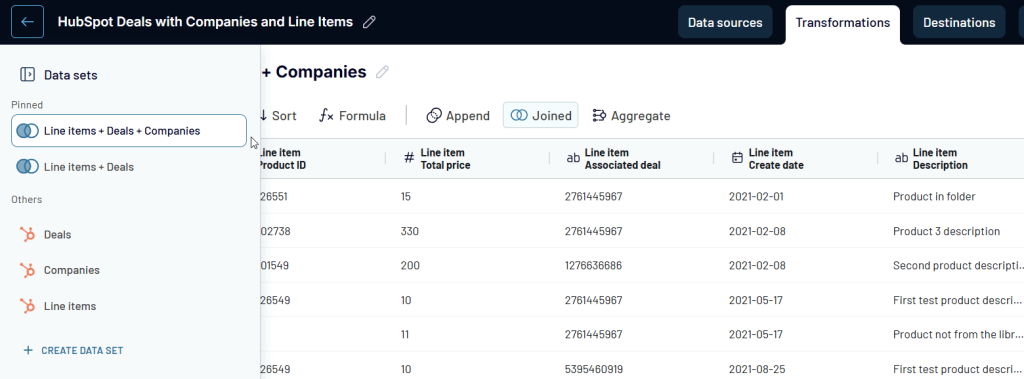
Step 2. Connect the data flow to AI
Once your source data is connected and organized, choose the desired AI tool from the list of destinations. For example, you go with ChatGPT. Follow the in-app instructions on how to integrate your data flow with ChatGPT and, IMPORTANT, run the data flow.

Step 3. Start your conversation
After the successful run, ChatGPT will be able to query the data from your Coupler.io data flow connected to your HubSpot account. You can launch conversational analytics on HubSpot data in ChatGPT and uncover actionable sales insights.
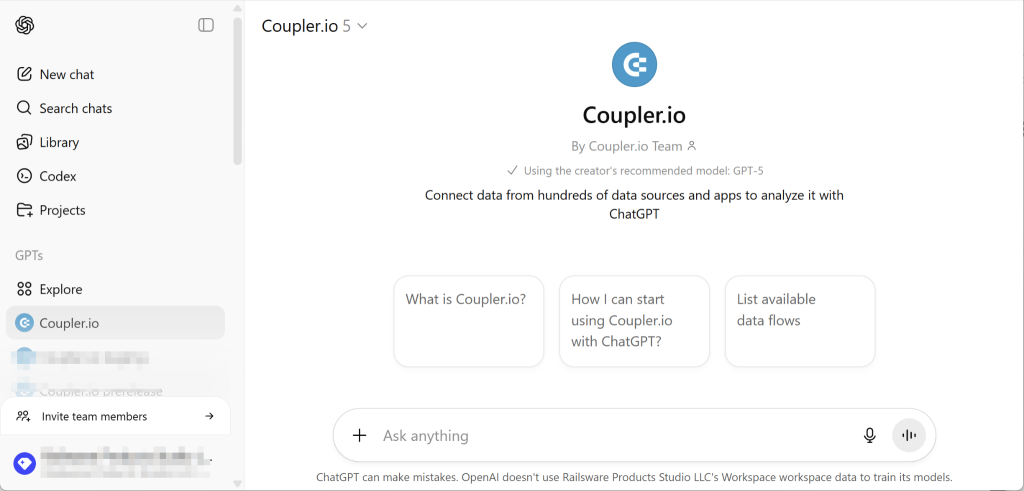
If you enable the automatic data refresh, Coupler.io will keep the data fresh in the data flow according to the set schedule. To ensure ChatGPT accesses the most recent data in your conversation, ask it to explicitly re-fetch the data from the most recent run or start a new chat.
Curious about exploring your HubSpot data in ChatGPT, Claude, or Perplexity? Start your free Coupler.io trial and connect your data to your favorite AI tools in minutes.
Integrate your sales data with AI for conversational analytics
Try Coupler.io for freeAI-powered sales insights examples
To demonstrate an example of conversation analytics of sales data in ChatGPT, I’ve connected a HubSpot data flow named HubSpot sales performance. I can ask ChatGPT whether it can see this data flow. The AI tools will always ask your permission to connect to the Coupler.io MCP server. It seems we’re good to go!
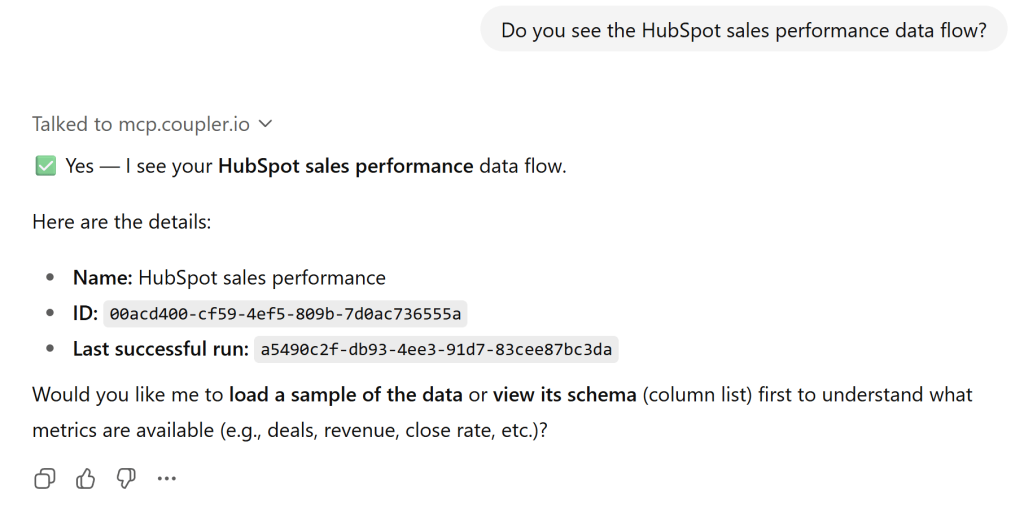
Use case 1: Sales performance & pipeline optimization
To improve pipeline efficiency and overall sales performance, it’s essential to know where opportunities progress smoothly, where they stall, and which channels drive revenue. AI can surface these patterns instantly when you guide it with the right prompts to analyze.
If you want to see where deals drop off and reveal hidden bottlenecks missed when only looking at total pipeline value, ask for conversion rates at each stage:
I want to see where deals drop off and reveal hidden bottlenecks missed when only looking at total pipeline value. Show me conversion rates at each stage of a pipeline in percentage of deals moving from stage to stage.
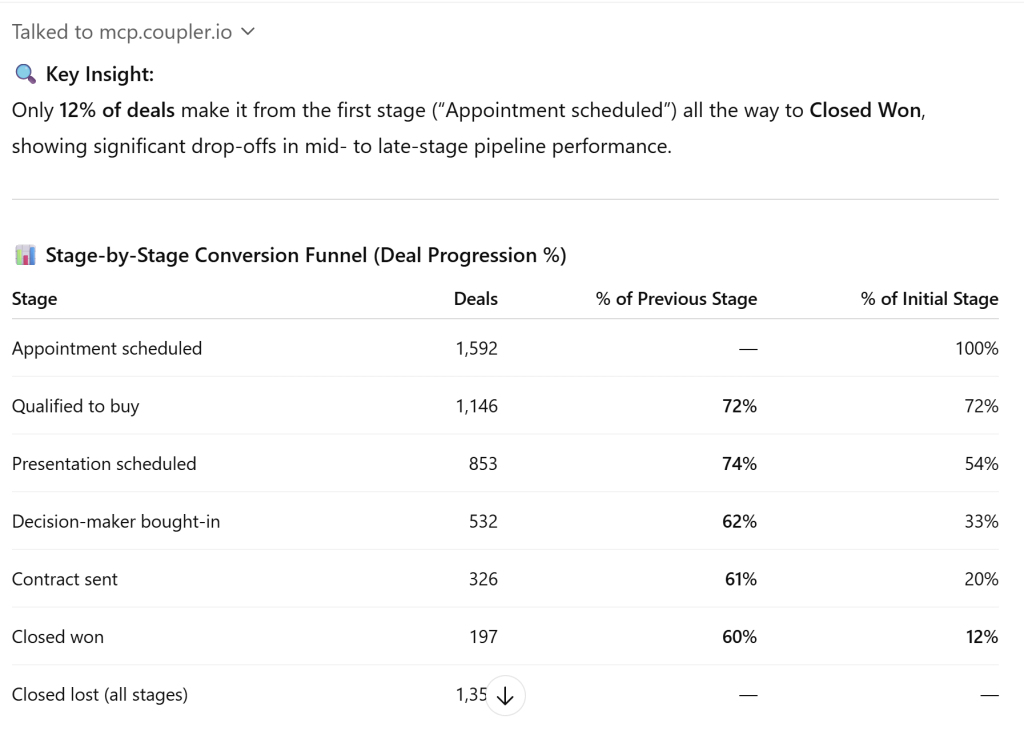
Learn more about the difference between sales pipeline vs sales funnel in our blog post.
Based on these AI-generated sales insights, here’s what you can act on:
- Investigate “Decision-maker bought-in → Contract sent” – 39% of deals fail here, often due to pricing objections or legal delays.
- Audit early qualification criteria – 28% drop-off from first contact suggests too many unqualified leads entering the pipeline.
- Reinforce follow-up processes – Strengthen sales enablement and automation in late stages to recover high-intent but stalled deals.
To understand which markets or teams generate large deals but fail to close them, or vice versa, request a comparison between the average deal size and the amount closed:
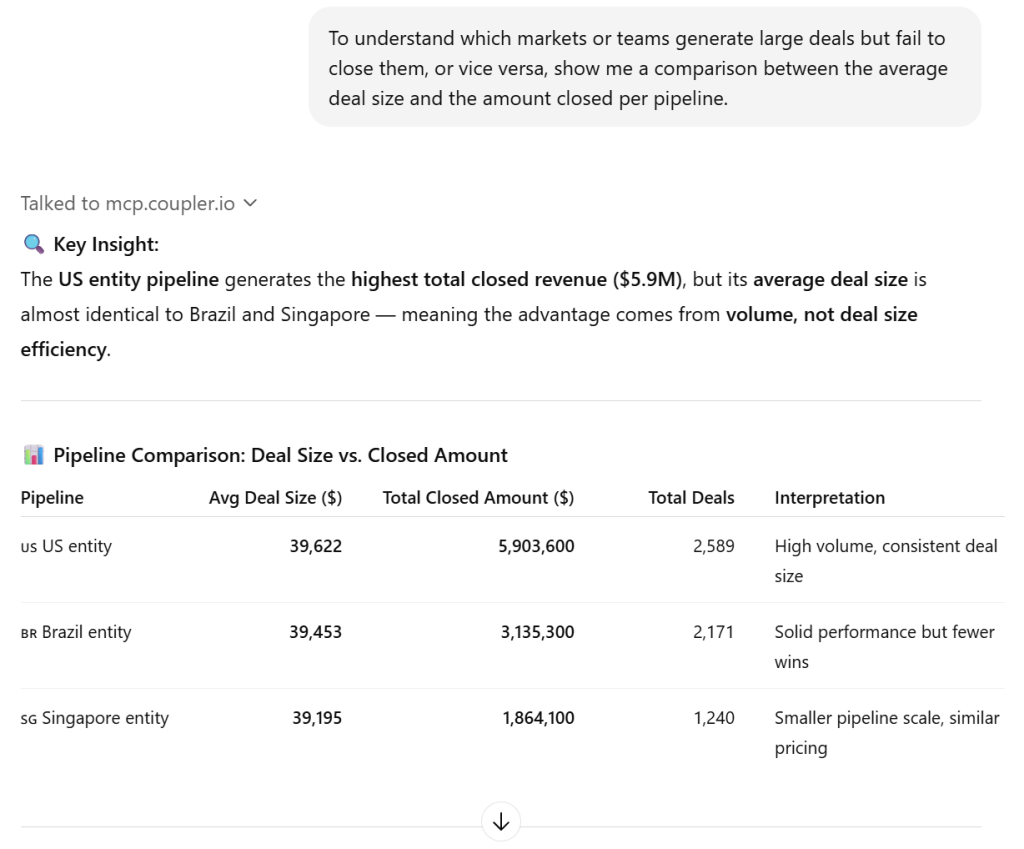
The AI suggests these actions based on the comparison:
- Investigate conversion rate gaps: Brazil and Singapore have strong deal sizes but lower closed totals — likely due to weaker close rates.
- Replicate US process playbook: Analyze US sales motions or incentives contributing to higher closure volumes.
- Target high-value deals selectively: Since deal sizes are uniform, focus expansion efforts on boosting close rates rather than increasing deal value.
When deciding how to allocate budget and resources, it’s not enough to measure lead volume. You need to know which sources actually help close. Ranking deal sources by revenue provides clarity on what’s working and what’s not:
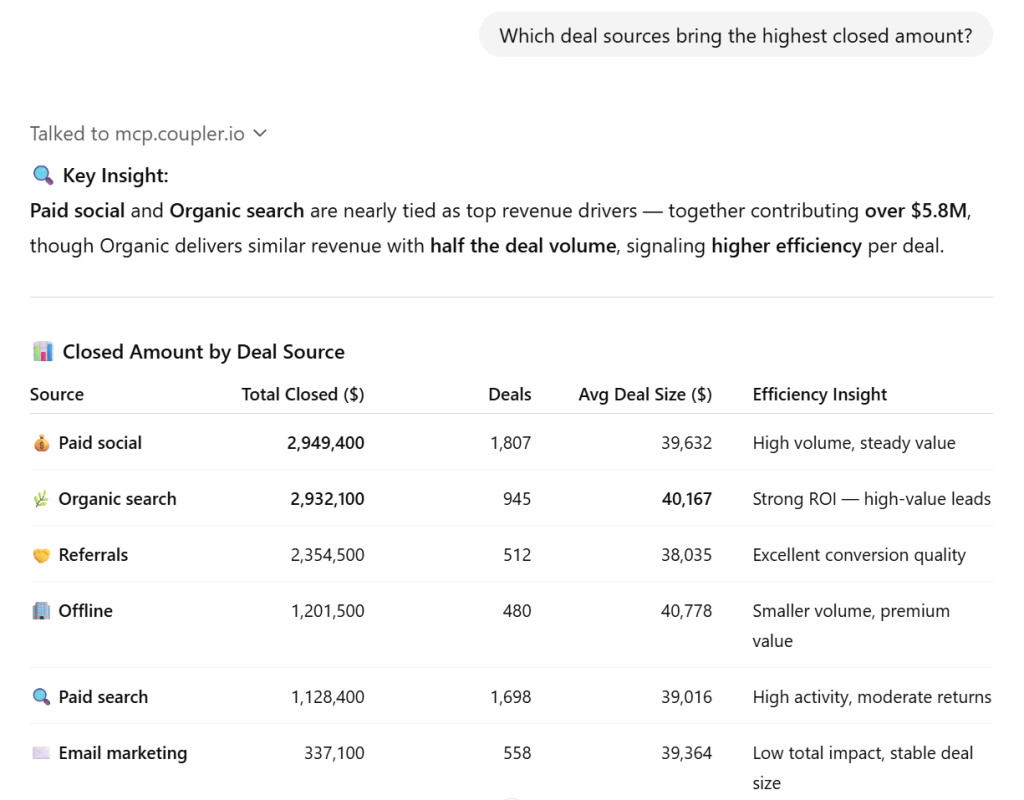
Here’s what the AI points to:
- Double down on Organic & Referrals — these channels close larger deals more efficiently.
- Audit Paid Social for quality — strong top-line revenue, but possibly lower win rates per deal.
- Test scaling Offline and Referrals — both yield above-average deal sizes with fewer leads.
With just three targeted AI prompts instead of time-consuming manual repetitive tasks, you see where deals fail, which regions underperform, and which lead sources truly drive revenue.
Use case 2: Listing top performers
To drive consistent sales growth, it’s essential to identify your top performers and determine which sources yield the most significant wins. This allows you to replicate success, support underperformers, and allocate resources where they bring the most value.
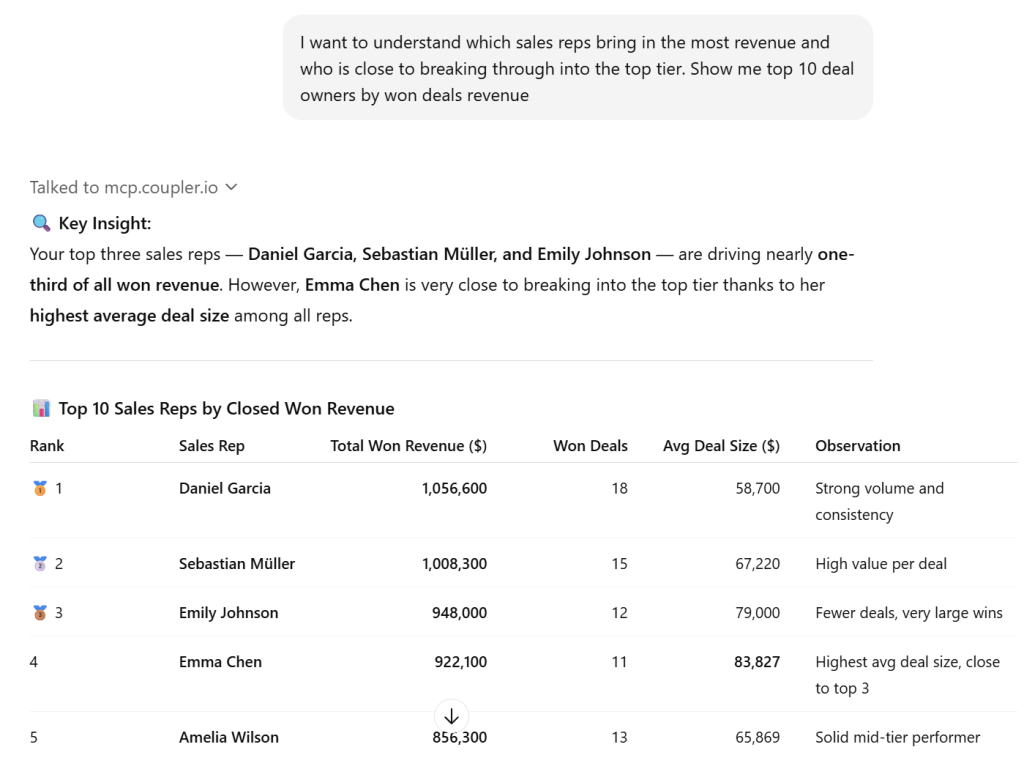
From the AI-driven insights, the following steps are recommended:
- Recognize top performers (Garcia, Müller, Johnson) — together they set the benchmark for both volume and value.
- Mentor & promote Emma Chen — her deal size efficiency shows she’s ready to enter the top 3 with slight pipeline growth.
- Coach high-volume reps (Sophia Liu, Mia Davis) to focus on deal value optimization, not just count.
If you want to see which channels are consistently generating closed revenue, request a list of the top-performing sources:
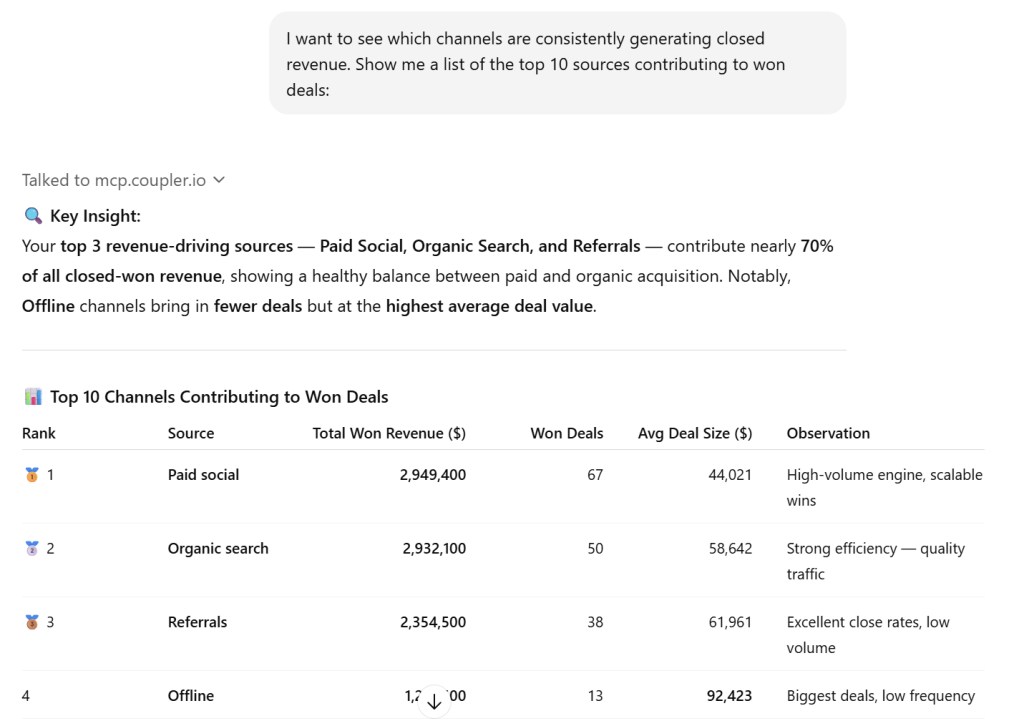
According to the AI-generated results, here’s how to act:
- Double down on organic & paid social: These two account for most of the revenue, so scaling content and ads here will maximize returns.
- Optimize Paid Social targeting — huge reach but slightly lower deal value per close.
- Reinvest selectively in Offline — though smaller in scale, its deal quality suggests it’s ideal for enterprise or strategic accounts.
To learn which sources, reps, and marketing strategies drive the biggest wins based on past successes, ask for a list of the largest deals closed over the last year:
I need to understand which sources, sales reps, and marketing strategies drive the biggest wins based on past successes. Show me a list of the top 10 biggest deals closed in the last 12 months.
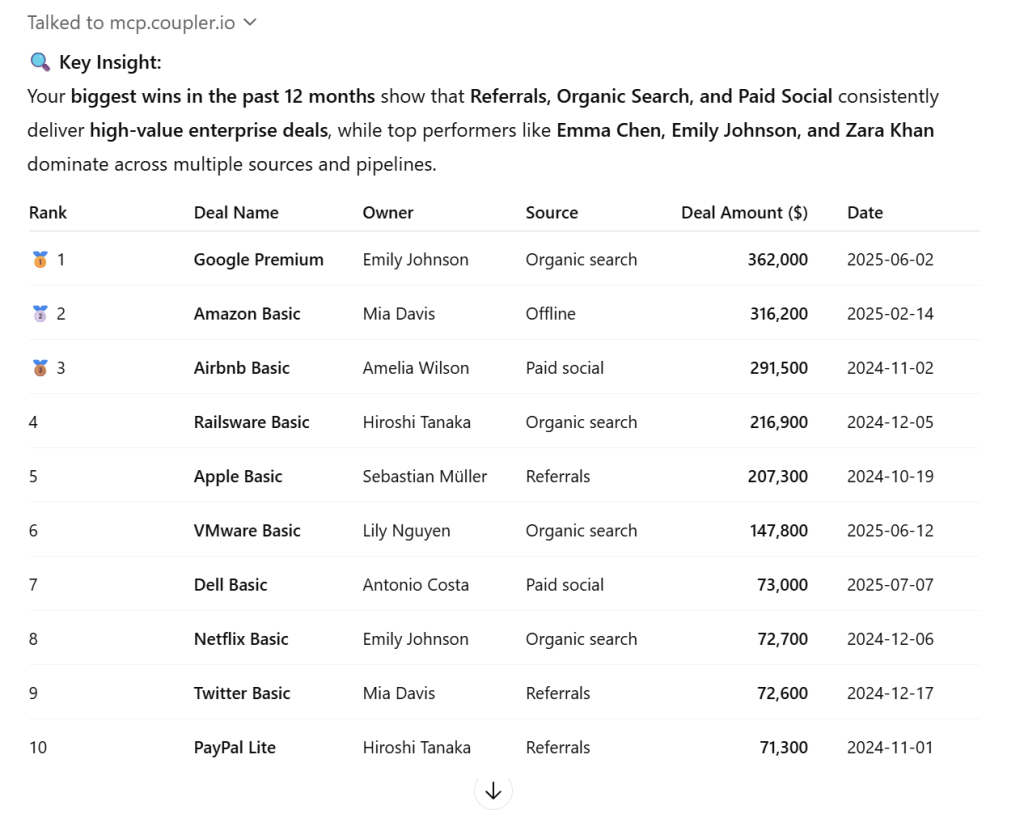
The AI points to these actions:
- Organic Search = Proven high-value engine — consistently yields top-tier enterprise deals (Google, Railsware, VMware, Netflix).
- Referrals & Offline excel in trust-driven closes — large-ticket deals like Amazon Basic and Apple Basic came from warm networks and personal relationshipsю
- Empower cross-functional alignment — Emily Johnson and Mia Davis show that marketing-sourced (Organic/Offline) and relationship-sourced (Referrals) deals can both scale.
By focusing on top performers, winning channels, and high-value deals, you gain a blueprint for scaling success across the entire sales team.
Use case 3: Filtering data
For strategic decision-making, it’s not enough to look at all sales metrics at once. You need to filter by time period, pipeline, or deal outcomes to understand where wins and losses come from.
If you want to focus on performance within a specific period, ask for closed deals in the chosen quarter:
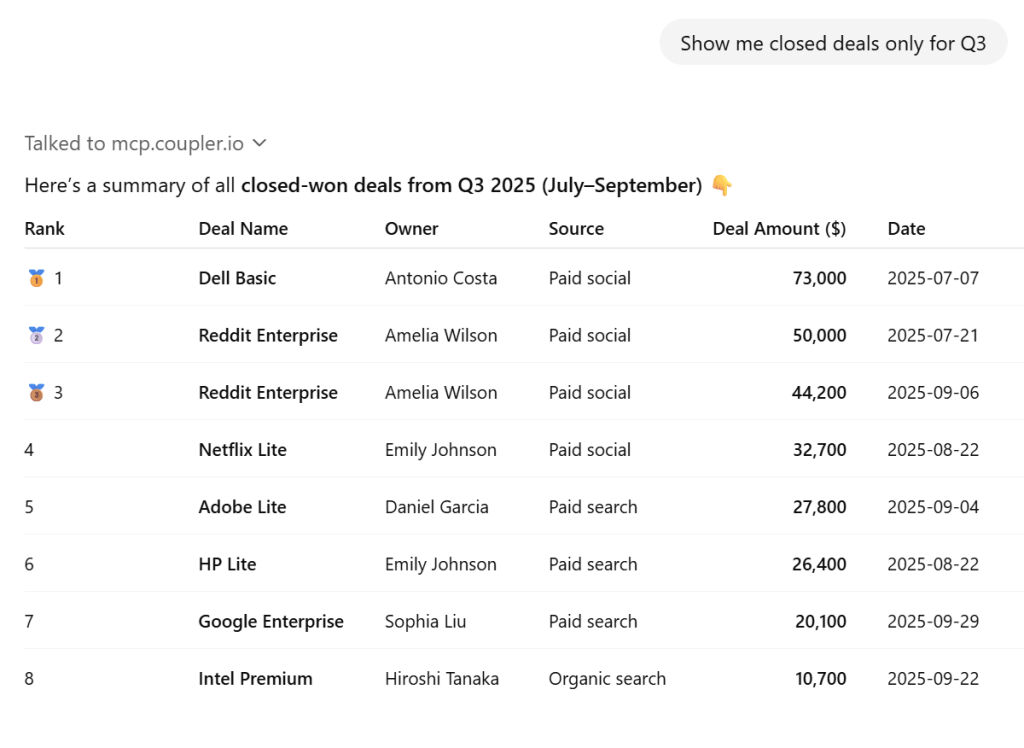
From the AI-driven insights for Q3:
- Paid Social dominates Q3 wins, accounting for 5 of 8 deals and over 60% of total closed revenue.
- Amelia Wilson leads in Q3 performance, closing two strong deals from Paid Social campaigns.
- Emily Johnson shows versatility — winning deals from both Paid Social and Paid Search.
- Organic Search remains present but minor in volume, closing one smaller high-margin deal.
If you want to see which sales activities and messaging approaches lead to closed revenue, group deals by pipeline type:
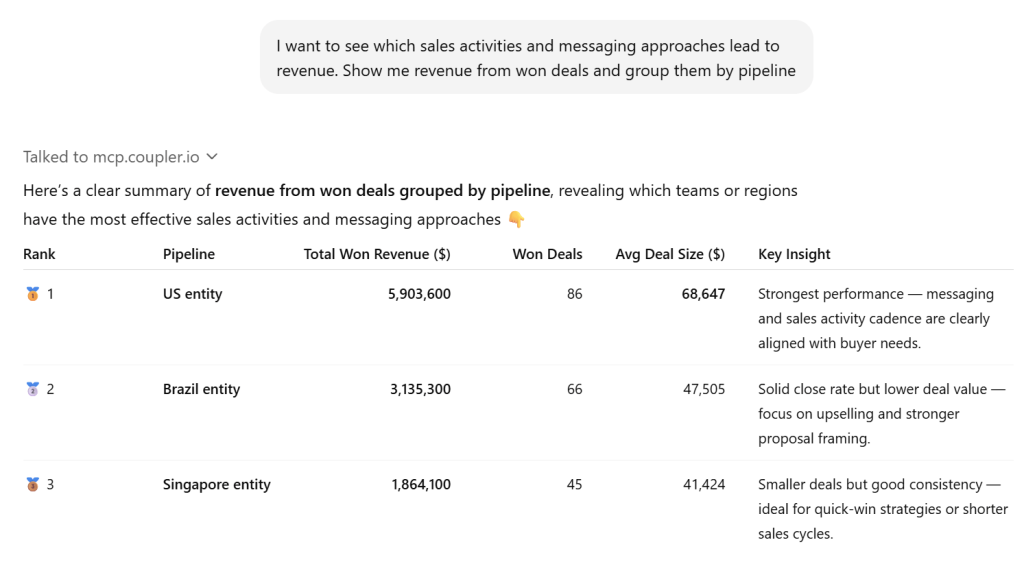
According to the AI-generated breakdown:
- US pipeline likely leverages a more refined messaging playbook and higher-touch outreach — translating into larger wins and faster closes.
- Brazil’s messaging likely resonates but needs refinement for higher perceived value (perhaps too discount-driven).
- Singapore may focus on volume over value — opportunity to introduce tiered pricing or bundled offers to increase deal size.
If you want to reduce churn and improve close rates, filter for recently lost deals and review loss reasons:
To reduce churn and improve close rates, filter for recently lost deals in the last 30 days, specifying their reasons
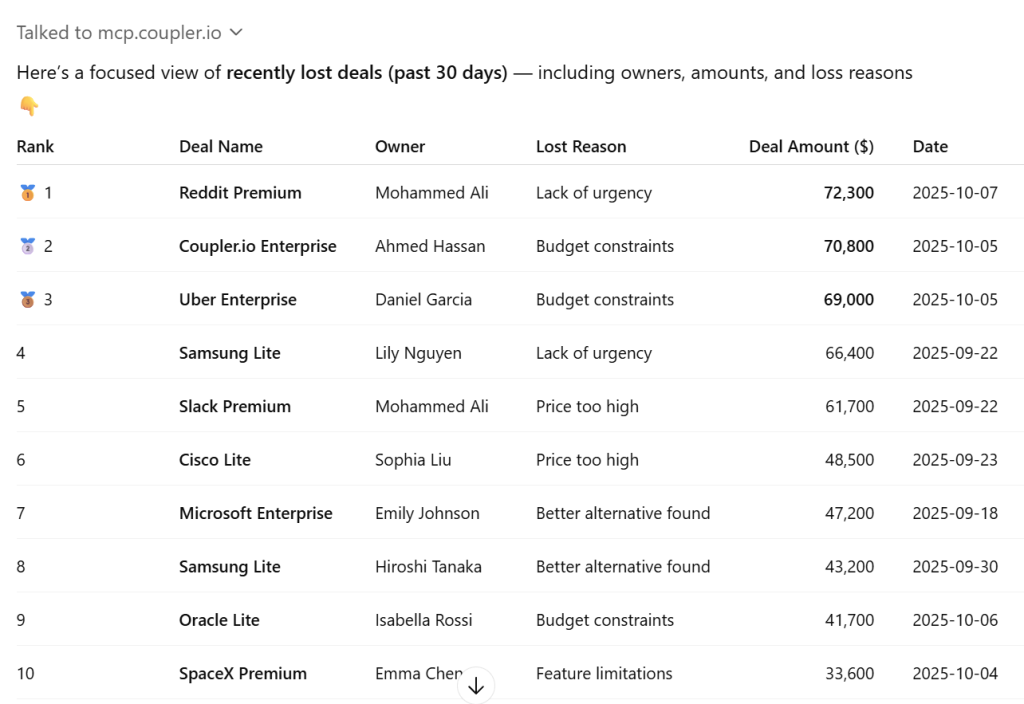
Based on the AI’s assessment of recent losses, there are top 3 loss reasons:
- Budget constraints (5 deals) — pricing sensitivity or perceived ROI gap.
- Feature limitations (5 deals) — product gaps likely hurting enterprise closes.
- Lack of urgency (3 deals) — deals stalling late-stage, suggesting messaging or follow-up misalignment.
High-risk pattern:
Repeated loss reasons among enterprise-tier deals (>$40K) imply strategic objections — not just price but value communication and timing issues.
By filtering your sales records with precise prompts, you can uncover quarter-specific wins, pipeline strengths, and recurring loss reasons, turning raw data into immediate action points.
Use case 4: Generating tables for sharing
When sales data needs to be presented to leadership or shared across teams, clear summary tables are more effective than raw sales reporting. By generating ready-to-use tables, AI helps you highlight performance patterns, compare reps or regions, and spot areas for improvement.
If you want to monitor sales progress month by month, ask for a summary table that combines deal counts and revenue:
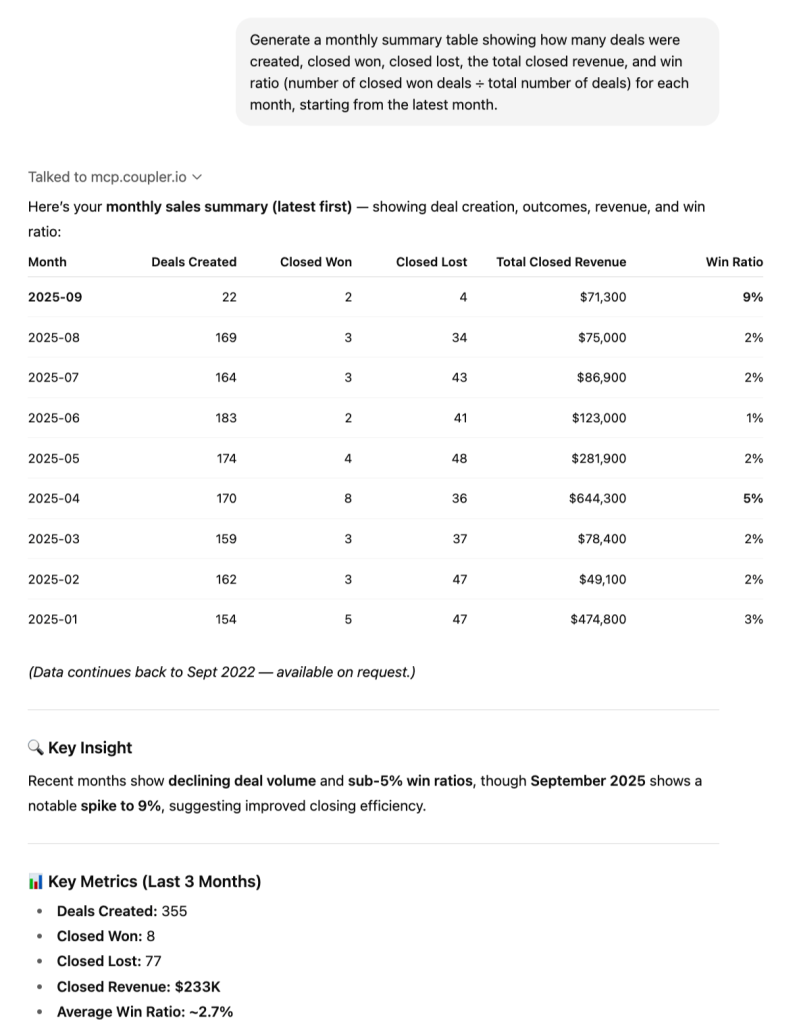
From the AI-generated summary table, here’s what stands out:
- Replicate September tactics: Something boosted win rates. Identify campaigns or offers driving stronger conversions.
- Audit pipeline stages: Conversion ratios suggest potential friction before close.
- Re-engage lost deals: Roughly 40-50 lost per month. Even a 10% recovery could yield ~$100K/month in extra revenue.
To see how individual reps perform beyond revenue alone, ask for a table showing won vs. lost deal counts:
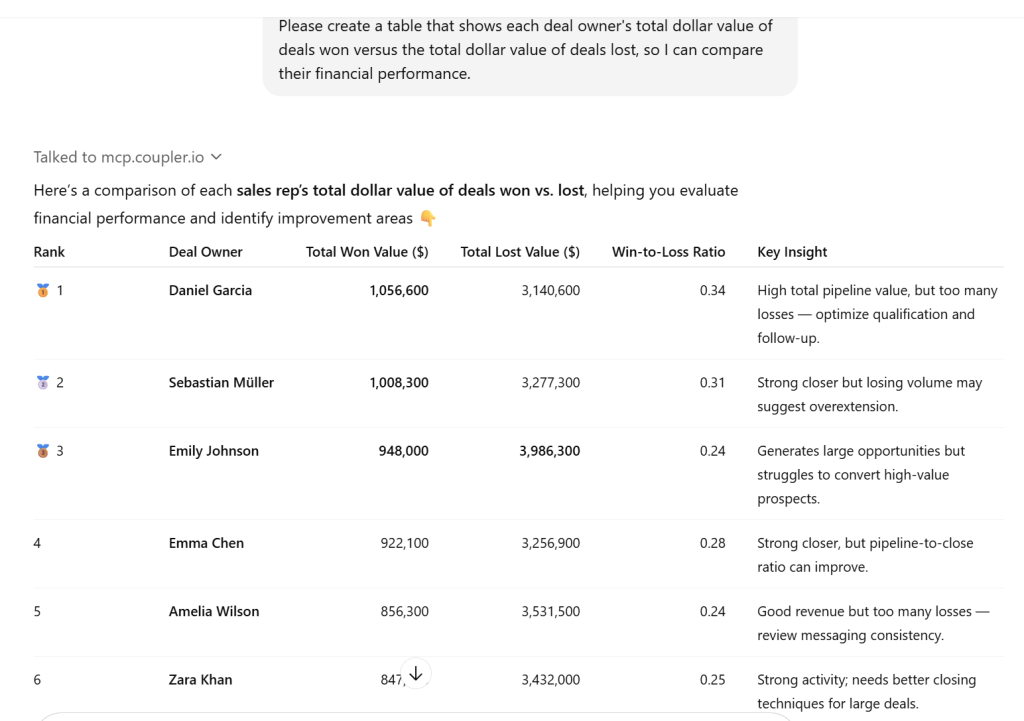
The AI points to these improvement areas:
- Analyze loss reasons for top pipeline performers (Garcia, Johnson) — reduce high-value churn.
- Coaching focus: prioritize objection handling and urgency for reps below 0.25 win/loss ratio.
- Reward efficiency: Emma Chen and Sebastian Müller show promise for leadership modeling.
If you want to compare markets or product pipelines side by side, ask for a table showing deal count, closed revenue, and win rate:
I want to compare markets (pipelines) side by side. Create a table showing deal count, closed revenue, and win rate by pipeline
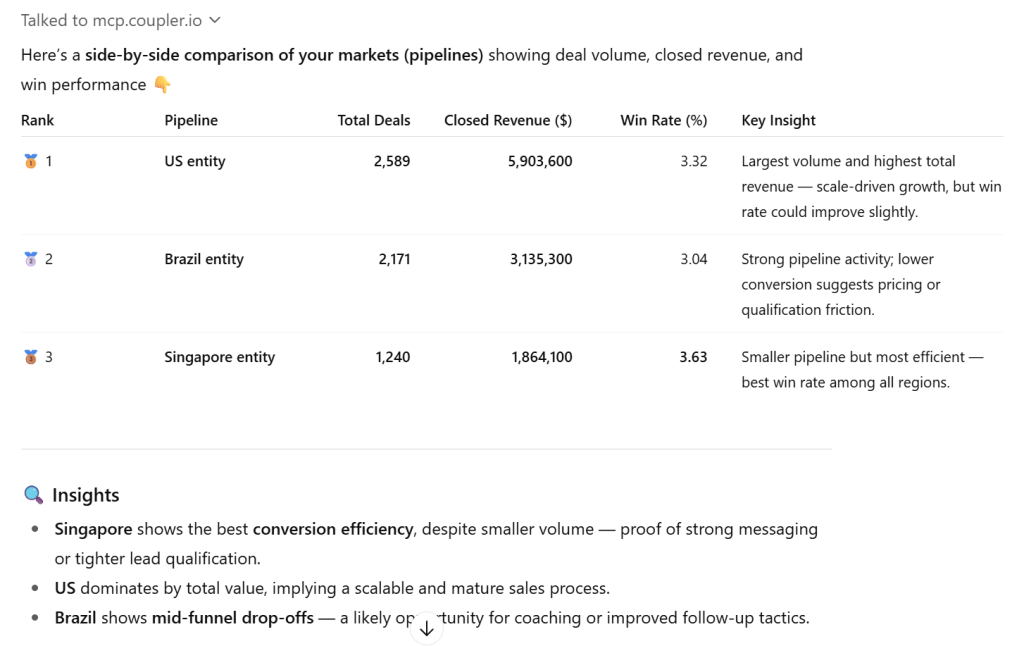
From the AI-driven comparison table, the following steps are clear:
- Singapore shows the best conversion efficiency, despite smaller volume — proof of strong messaging or tighter lead qualification.
- US dominates by total value, implying a scalable and mature sales process.
- Brazil shows mid-funnel drop-offs — a likely opportunity for coaching or improved follow-up tactics.
With tables generated on demand, you can quickly summarize performance, highlight efficiency gaps, and guide leadership conversations without spending hours preparing reports.
Use case 5: Diagnosing poor performance
To improve overall sales effectiveness, identify why deals fail, which reps underperform, and where opportunities drop off in the pipeline. AI can quickly analyze loss patterns, close rates, and pipeline transitions to pinpoint root causes.
If you want to understand why opportunities didn’t close, ask for a ranked list of loss reasons:
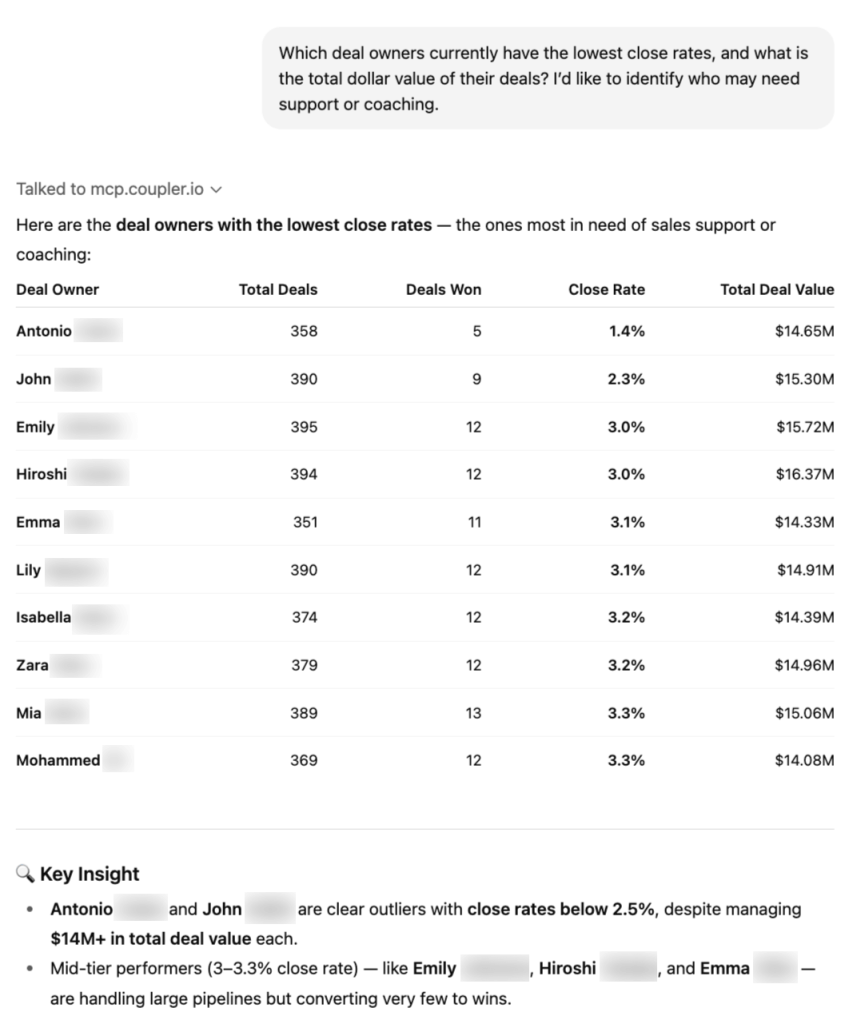
From the AI analysis, focus on these actions:
- Targeted coaching for low performers: Antonio and John likely need help with negotiation or qualification strategy.
- Pipeline quality review: High total deal values with low conversion may indicate poor lead fit or stage misalignment.
- Replicate top performers’ tactics: Compare messaging, timing, or pricing strategy with higher close-rate reps like Daniel or Sebastian.
To highlight where deals stall and prevent revenue loss, request a pipeline stage conversion analysis:
Can you analyze the pipeline stages and point out where we’re seeing the biggest drop-offs in deal progression? Please include both the total number of deals and percentage changes between stages.
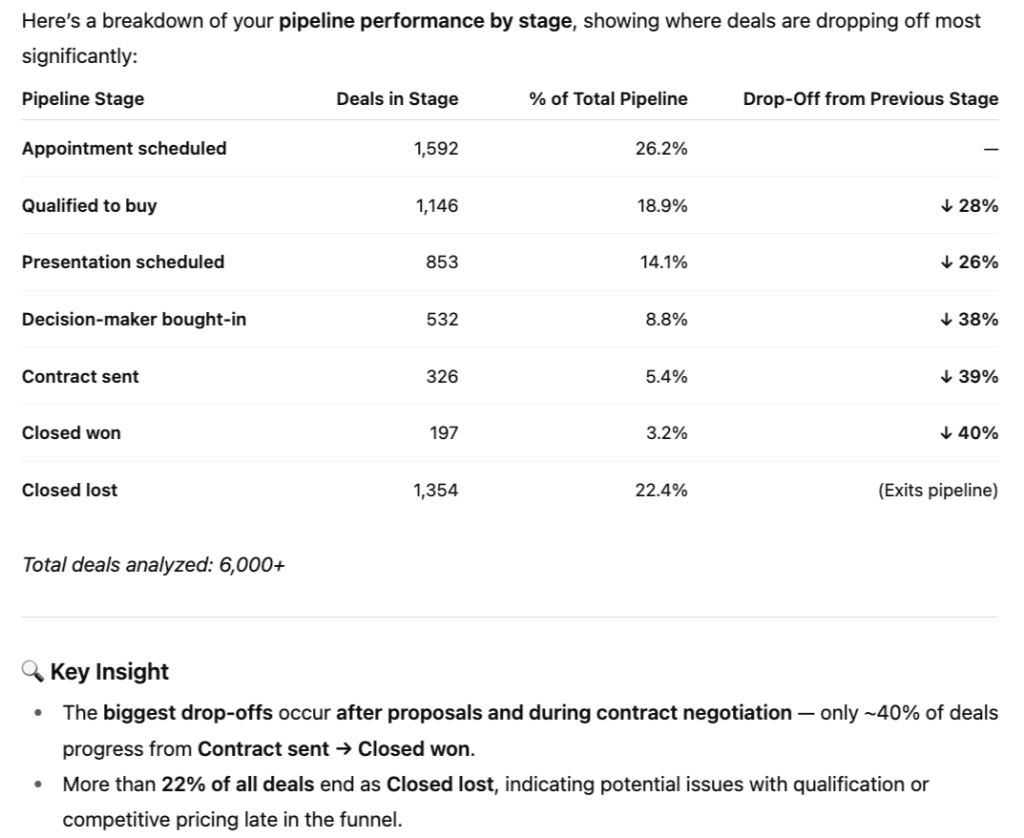
Based on AI-generated stage analysis, act as follows:
- Strengthen late-stage follow-ups: Focus on negotiation and decision support when contracts are sent to reduce final drop-offs.
- Improve qualification: Refine early filtering (post-Appointment scheduled) to ensure higher conversion downstream.
- Review lost reasons: Analyze the Closed lost reason column to identify recurring blockers (price, timing, competitor, etc.).
Using these prompts, you can quickly diagnose why deals fail, who needs targeted support, and where the pipeline is leaking.
Use case 6: Budget-constrained recommendations
When resources are limited, it’s critical to know which channels, pipelines, or reps provide the highest return on investment. AI can analyze historical performance and suggest where to allocate the budget for maximum impact.
If you want to focus your spend on channels that generate revenue at the lowest cost, ask for ROI rankings of deal sources:
If I had a $250,000 marketing budget to invest, which sources or pipelines would give us the highest potential return based on past performance?
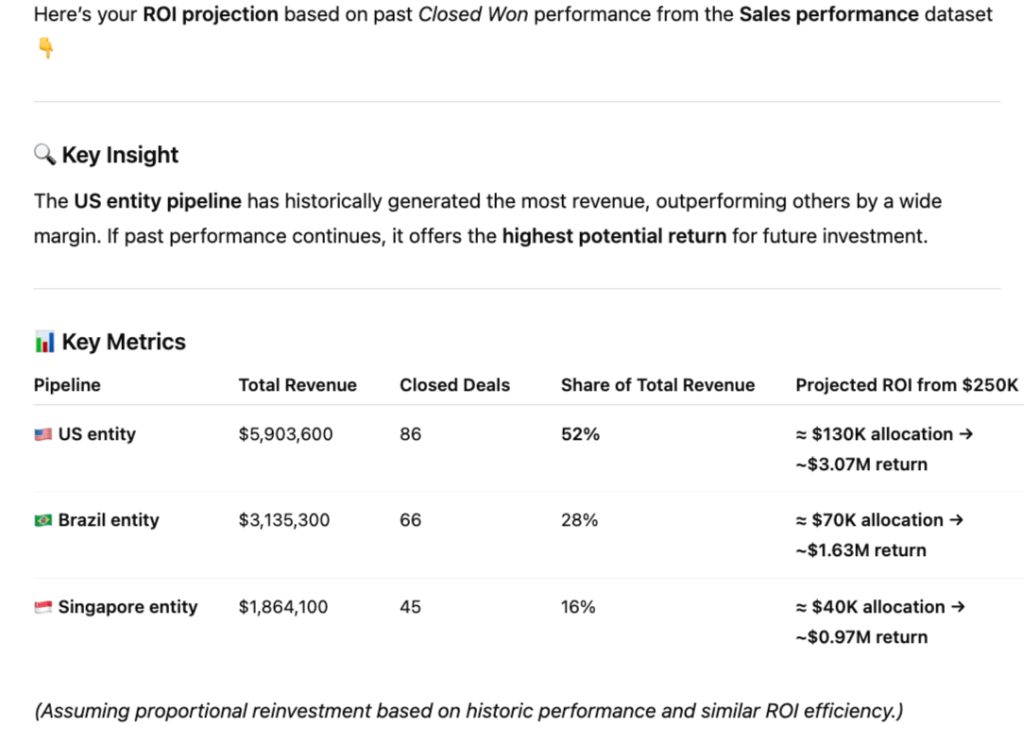
The AI suggests this allocation for $300:
- Double down on US entity: It delivers the strongest return per deal and the largest overall yield.
- Best optimization in Brazil: Good conversion volume; moderate returns could grow with targeted campaigns.
- Refine Singapore’s sales funnel: Smaller pipeline but positive yield; ideal for nurturing higher-value deals.
If you want to increase win rates without increasing spend, ask for AI-driven recommendations to strengthen the stage with the most significant drop-offs:
Based on the data, suggest specific actions or optimizations we can make to improve conversion rates in the Appointment scheduled → Qualified to buy stage transition.
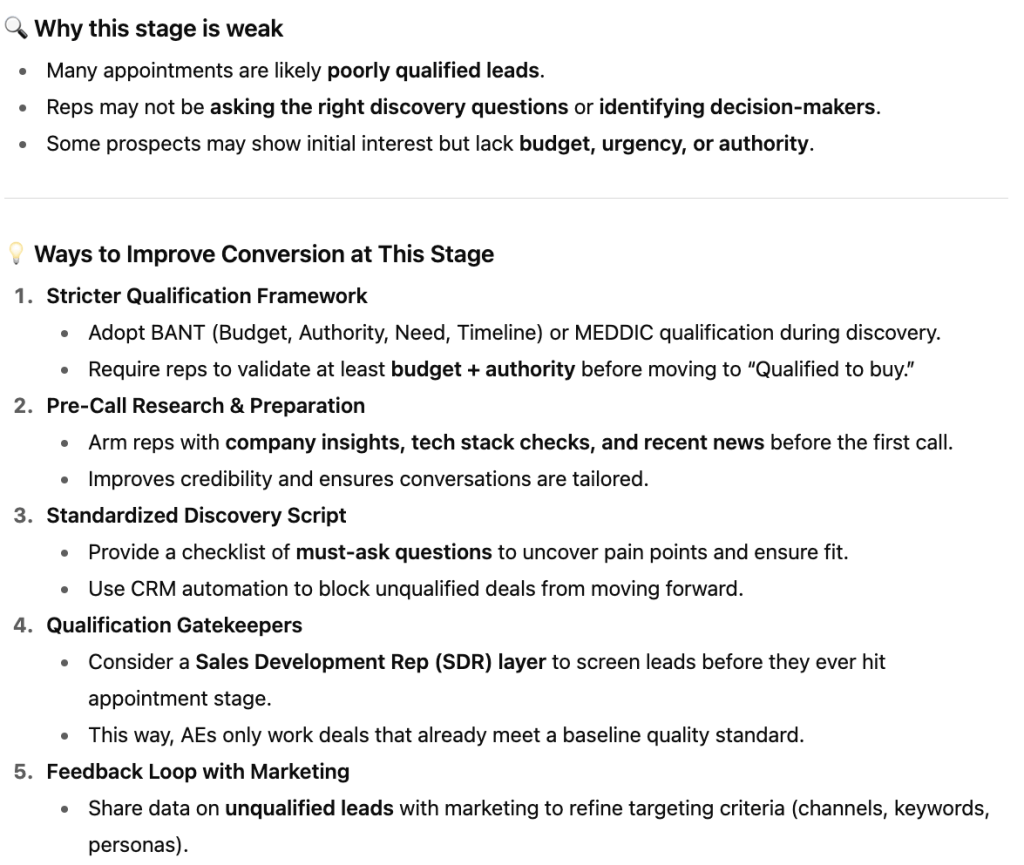
Based on AI insights, implement the following measures:
- Stricter qualification framework: Adopt BANT or MEDDIC during discovery. Require reps to validate at least budget + authority before advancing deals.
- Pre-call research & preparation: Equip reps with company insights, tech stack checks, and recent news to ensure tailored, credible conversations.
- Standardized discovery script: Use a checklist of must-ask questions to uncover pain points and fit. CRM automation can block unqualified deals from moving forward.
- Qualification gatekeepers: Consider a Sales Development Rep (SDR) layer to screen potential customers before account executives engage, to only quality deals progress.
- Feedback loop with marketing: Share data on unqualified leads to refine targeting, including channels, keywords, and personas.
Using these prompts, you can prioritize budget allocation, strengthen weak pipeline stages, and maximize ROI even under financial constraints.
Use case 7: Sales forecasting
To anticipate revenue and make proactive data-driven decisions, you should understand how current pipelines translate into future closed deals. AI can analyze deal stages, values, and conversion rates to provide accurate forecasts and reveal opportunities to increase next month’s revenue.
If you want to predict next month’s revenue, highlight potential upside, and prioritize efforts where they matter most, ask for a forecast based on open deals and historical conversion rates:
Forecast closed revenue for next month based on current pipeline.
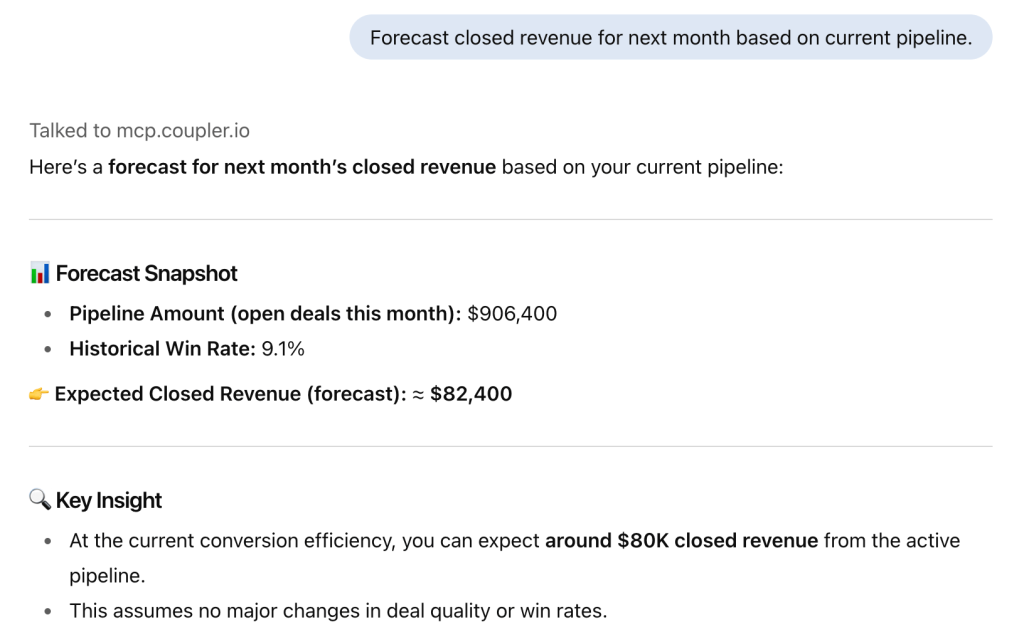
Based on AI-driven sales forecasting insights:
- Upside potential: Improving win rate by just +2% (to 11%) increases forecasted revenue to $99K.
- Pipeline growth: With ~$906K in open deals, increasing top-of-funnel activity will directly boost next month’s revenue.
- Deal prioritization: Focus reps on high-value, late-stage deals to maximize closures.
If you want to understand which regions or pipelines contribute most under current conditions, request AI to calculate expected closed amounts by pipeline:
Estimate the expected closed amount by each pipeline for the next month if our current conversion trends continue.
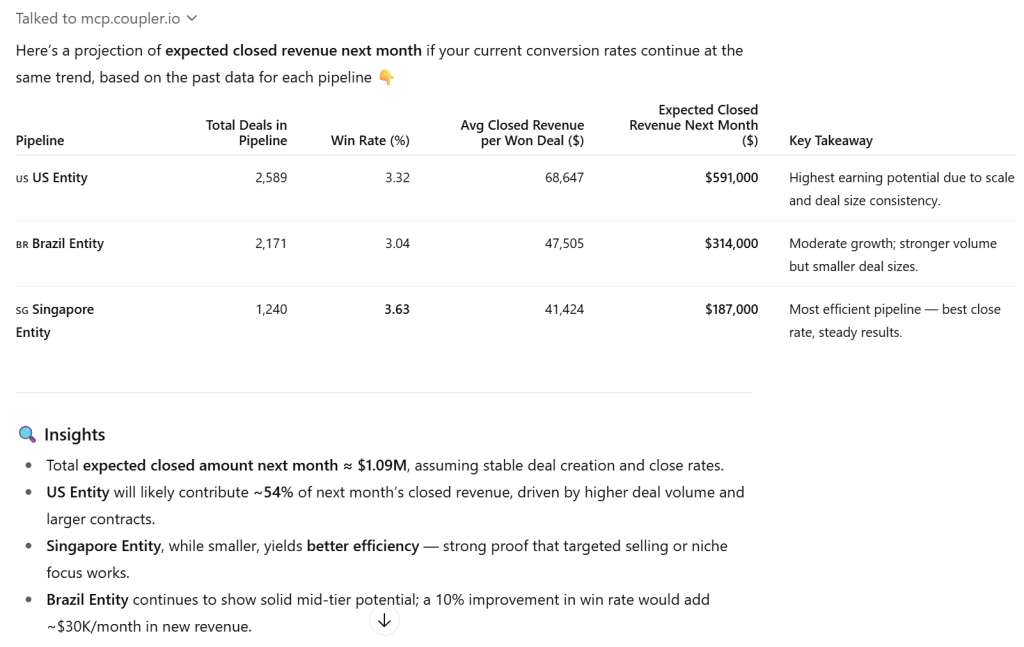
From AI-generated pipeline forecasts:
- Replicate Singapore’s approach (shorter cycles, higher close rates) in Brazil to boost yield.
- Reinforce US pipeline automation — its scale means even minor conversion lifts yield significant revenue.
- Focus marketing on qualified inbound in high-performing segments to maintain healthy deal flow without overwhelming reps.
To present forecasts clearly and see at a glance which pipelines drive revenue or where interventions may be needed, ask AI to generate a visual chart:
Show this forecast as a column chart so I can visually compare pipeline contributions.
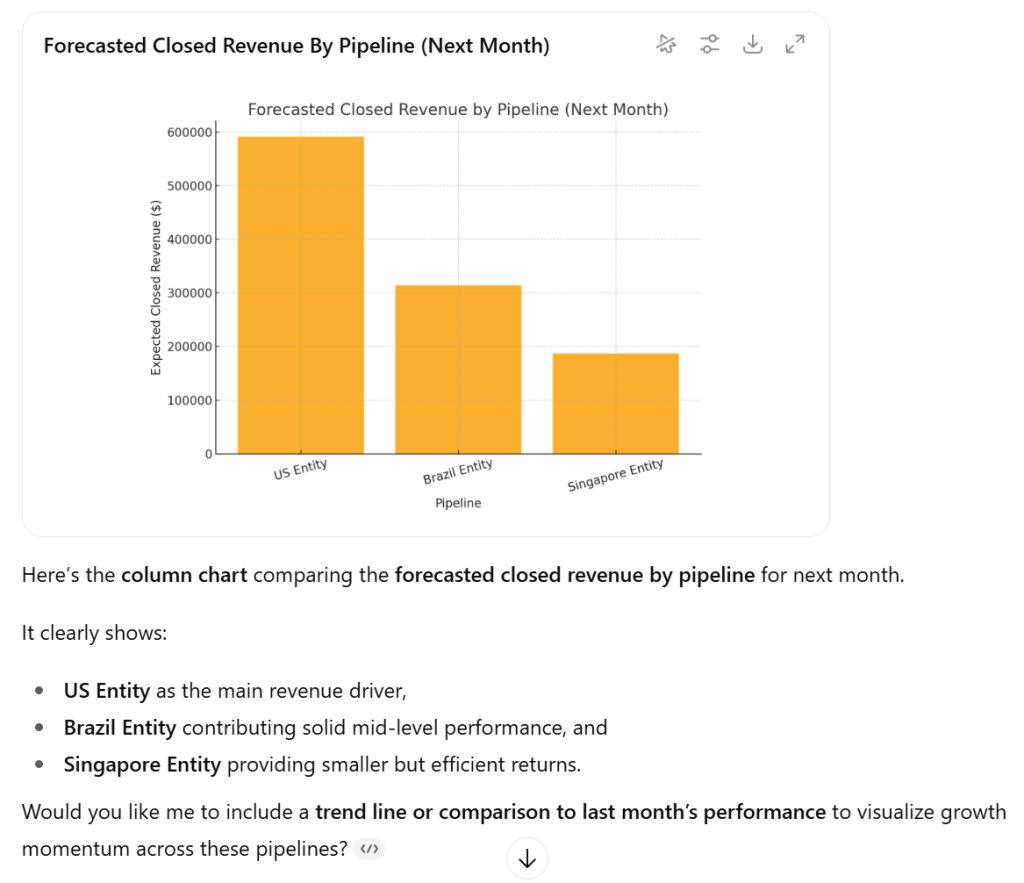
Visual forecasts make it easier to:
- Compare pipeline contributions instantly.
- Highlight high-value opportunities that require immediate attention.
- Communicate potential revenue scenarios with leadership or the sales team.
By generating both numerical and visual forecasts, you can plan next month strategically, prioritize high-value deals, and allocate resources across pipelines for maximum revenue.
Get AI-driven insights into your sales data with Coupler.io
Get started for freeBonus: Template for your sales insights dashboard powered by AI
To gain immediate visibility into your pipeline, deal velocity, and sales team performance, use the Coupler.io Pipedrive CRM dashboard. Powered by AI, this sales dashboard proactively flags issues and uncovers opportunities before they impact results.
Here’s what you can learn from this dashboard:
- Revenue forecasting & pipeline health: Instantly see weighted pipeline value and upcoming deal closures, helping managers plan resources and predict revenue accurately.
- Performance monitoring: Compare sales reps by deal status – won, lost, or open – to identify sales leaders and those who may need support.
- AI-driven deal insights: Identify bottlenecks, including low win rates and slow deal velocity. It highlights pipeline risks, like a high lost-to-won deal ratio, and recommends targeted actions focusing on strategic accounts to accelerate closures.
With generative AI insights from this dashboard, you don’t just react but instantly understand complex data, spot hidden trends, and receive targeted recommendations. Instead of spending hours digging through charts, you get clear, storytelling-driven summaries in under 30 seconds.
This saves time on analysis and reporting, helps you communicate performance with confidence, and guides you toward practical actions like reallocating budgets or pausing underperforming campaigns. The result: a pipeline that’s actively optimized to boost conversion rates and shorten deal cycles.
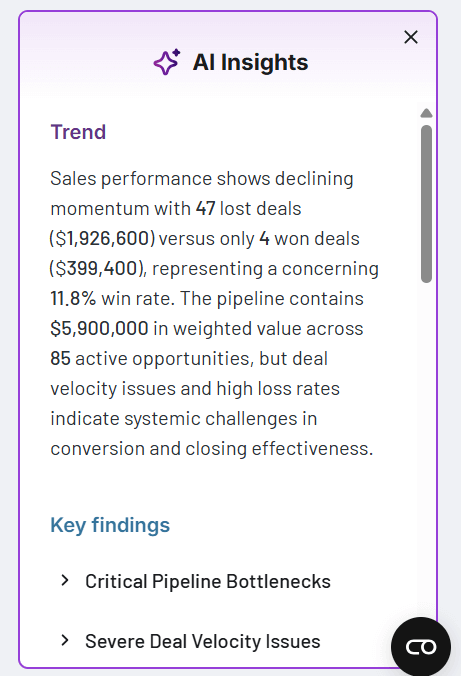
If, however, you want to ask questions and explore scenarios from your sales datasets in real time, Coupler.io’s AI integrations are the way to go. Use them to pull your data automatically from sources like HubSpot, Salesforce, Pipedrive, or ActiveCampaign into ChatGPT or Claude.
Get started today and turn your sales data into informed decisions.
Automate sales reporting with Coupler.io
Get started for freeHow can AI-driven engagement insights enhance sales conversations?
AI solutions transform the way sales teams interact with prospects by analyzing both past and real-time insights into engagement. This allows you to tailor their conversations with precision so that every interaction is relevant and delivered at the right time.
Better-intent leads
Not every inbound action signals buying readiness. A prospect downloading an e-book or clicking a pricing button doesn’t necessarily mean they are close to purchasing. Treating such interactions as high-value leads can waste time and resources.
AI solves this by combining CRM insights, historical customer engagement patterns, and intent signals to build a clearer picture of a prospect’s readiness. By qualifying leads through these multiple data layers, you can avoid low-value pursuits. Instead, this lets you focus only on accounts that truly show buying potential and prioritize the prospects most likely to convert.
Capturing buyer cues during calls
Cold calls and scripted sales pitches frequently miss the most valuable cues: emotions, hesitations, objections, or even subtle interest signals. AI-powered revenue intelligence platforms can analyze sales calls in real time. For example, such AI-driven sales insights for agencies help spot when a prospect hesitates over a retainer fee, compares your services to competing agencies, or reacts positively to a unique campaign proposal.
This gives sales professionals tools for real-time coaching, while reps can leverage these insights to personalize follow-ups with context from the conversation. The result is a more natural, customer-centric dialogue instead of a one-size-fits-all script. Using AI call analysis is reported to drive a 41% increase in win rates and 30% shorter deal cycles.
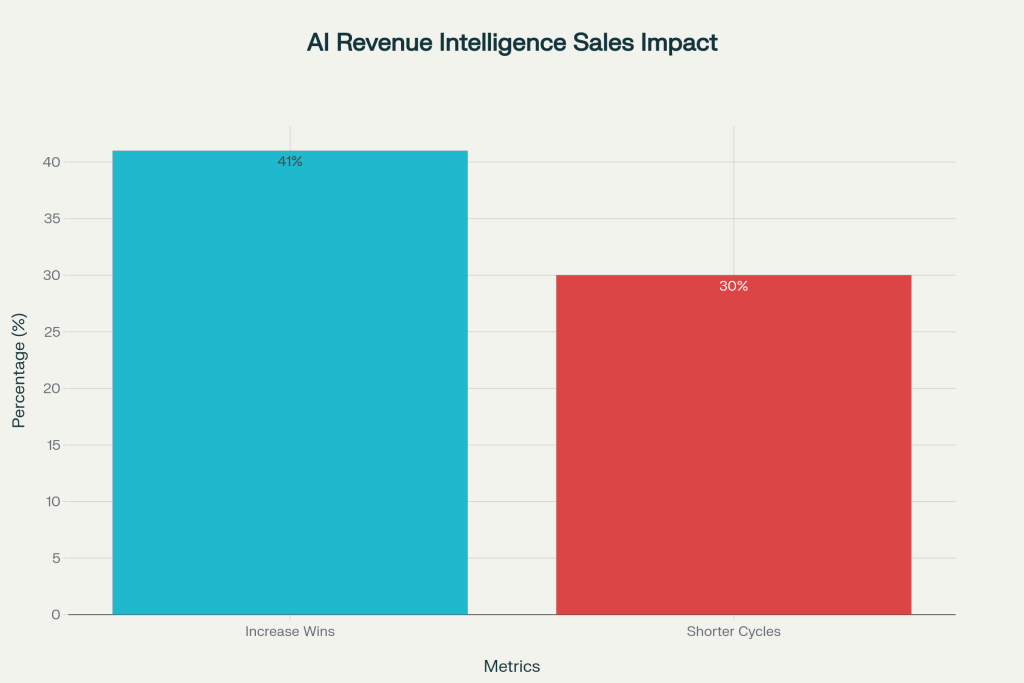
Personalized customer experiences
Customers today expect more than generic interactions: they want experiences tailored to their needs and preferences. AI enables this by analyzing behavior, purchase history, and sentiment across multiple touchpoints. You can use it to predict future needs, segment customers based on preferences, and recommend products or services that match individual profiles.
Such personalization builds trust, strengthens relationships, and significantly increases the likelihood of conversion. Instead of pushing irrelevant offers, you engage customers with solutions that feel uniquely designed for them.
Predictive lead scoring & Next Best Action (NBA)
Manual lead scoring often relies on guesswork or outdated rules, which can be slow and error-prone. AI enhances this process by using predictive analytics to rank prospects based on their likelihood to convert. Besides, AI can also recommend the “next best action” (NBA) or “next best offer” (NBO) tailored to each prospect’s stage in the buyer journey.
This lets you focus on the highest-value opportunities and approach each conversation with confidence and clarity.
Sales forecasting & dynamic deal scoring
To set realistic targets and align business strategy, you require accurate forecasting. AI improves forecasting accuracy by analyzing historical data, market trends, and external factors like seasonal changes. These insights empower you to anticipate opportunities, mitigate risks, and adapt quickly to changing conditions.
In addition, you can use AI to enhance pricing and deal strategies through dynamic deal scoring. By evaluating similar deals and customer willingness to pay, AI helps determine optimal pricing packages and discount levels. This ensures you maintain competitiveness without sacrificing profitability.
AI-driven forecasting models can achieve up to 95% accuracy, 20-50% better than traditional methods. As for dynamic deal scoring, it has already been proven to boost return on sales by 3-6%.
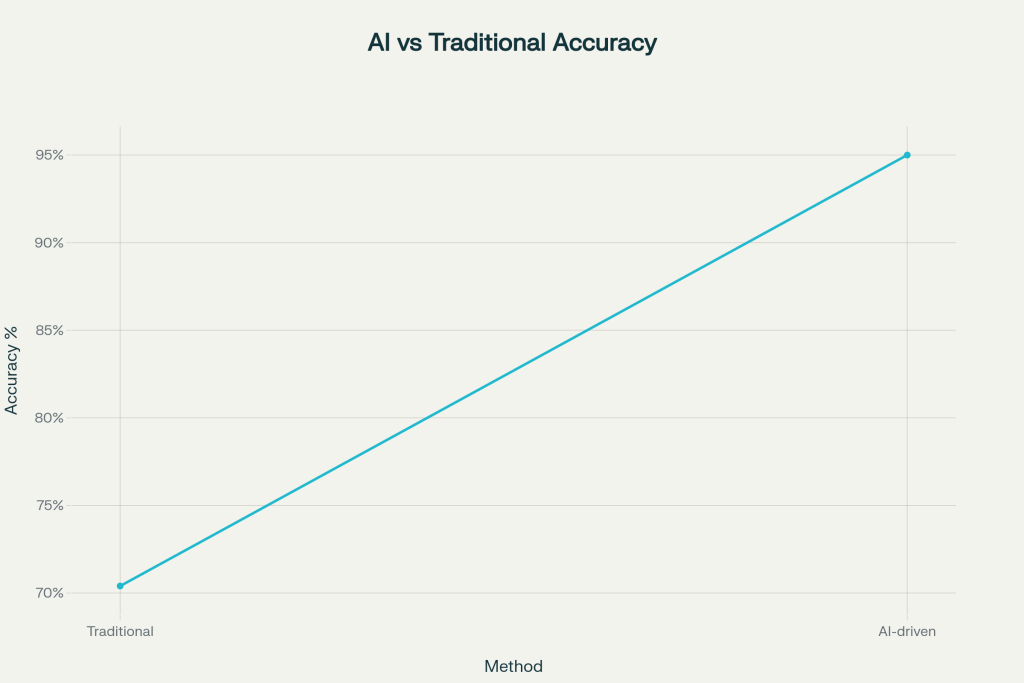
Overall impact: AI-driven sales insights for agencies and other businesses fundamentally change sales conversations by making them more intelligent and impactful. You spend less time chasing unqualified leads and more time engaging prospects who are ready to buy. Conversations become richer through the detection of subtle buyer cues, and personalization ensures customers feel understood.
The outcome is clear: shorter sales cycles, higher conversion rates, faster closed deals, stronger customer satisfaction, and 6-10% revenue growth.
Note: Using AI for sales insights requires addressing data quality issues (60% of CRM records are incomplete or inaccurate) and integration challenges, cited as a top barrier.
Successful real-world cases with AI-powered sales insights
The integration of AI technology into sales workflows has revolutionized how companies approach revenue generation and customer acquisition. The examples of Spotify, Delta Air Lines, and Amazon demonstrate how AI-driven sales insights go far beyond traditional analytics to create sophisticated revenue engines that function at scale.
Spotify: Machine learning as a sales revenue engine
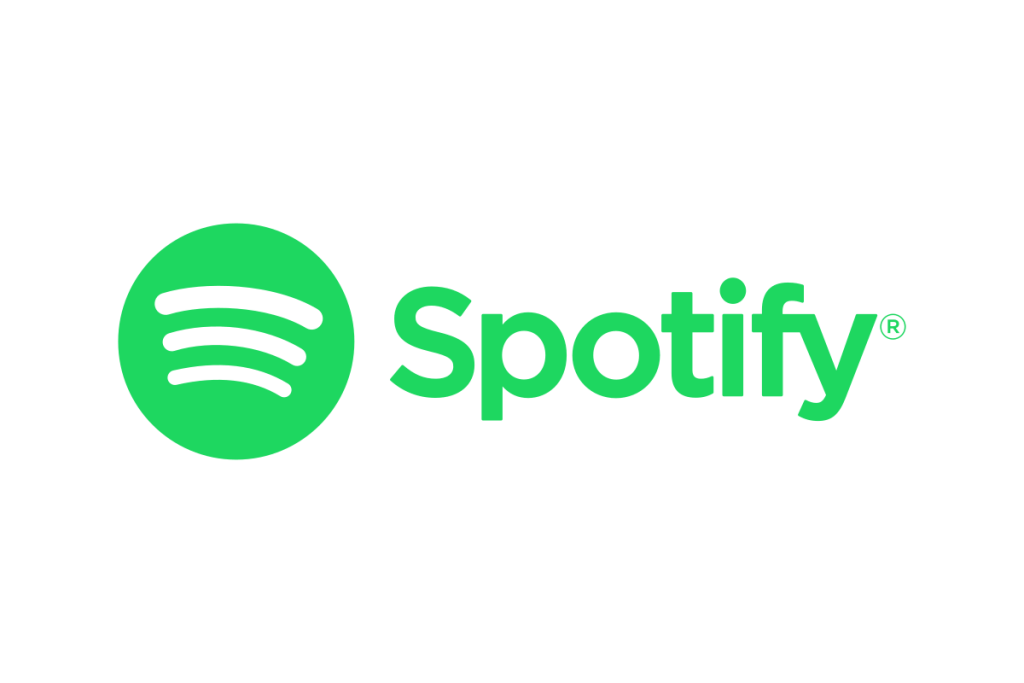
Spotify has transformed AI insights into a global sales machine that processes over half a trillion events daily to drive revenue growth, generating €4.2 billion in Q4 2024 alone. The company’s advertising business uses machine learning for targeted ad placement. This results in ad-supported revenue of €1.85 billion in 2024. Spotify Advertising achieved a 40% rise in sales team productivity by implementing automated seller activity capture and AI-powered lead scoring. Meanwhile, personalized web content driven by AI led to a 53% increase in CTR.
The platform’s subscription sales operate through a freemium funnel, where the BaRT algorithm strategically showcases premium features at optimal engagement moments to maximize conversions. This approach increased subscribers 11% year-over-year to 263 million. Spotify’s sales operations also demonstrate advanced forecasting capabilities, delivering predictable revenue within 1-3 percentage points. Enterprise sales representatives are now achieving 96% accuracy, compared to previous 80-90% rates.
Delta Air Lines: Smart revenue management

Delta Air Lines has implemented an AI-driven pricing system, currently determining prices for approximately 3% of its domestic flights, with plans to expand to 20% by the end of 2025. The system combines Delta’s internal data with external variables like weather patterns and market trends to estimate each customer’s willingness to pay. This enables continuous real-time fare adjustments rather than traditional static pricing models.
This AI-driven approach operates as what Delta calls a “super analyst” working 24/7. It presents higher prices to less price-sensitive business travelers while offering competitive pricing to leisure customers who shop around. The business impact has been substantial, with research indicating that personalized pricing can increase airline profits by up to 5%.
Amazon: AI-powered sales ecosystem
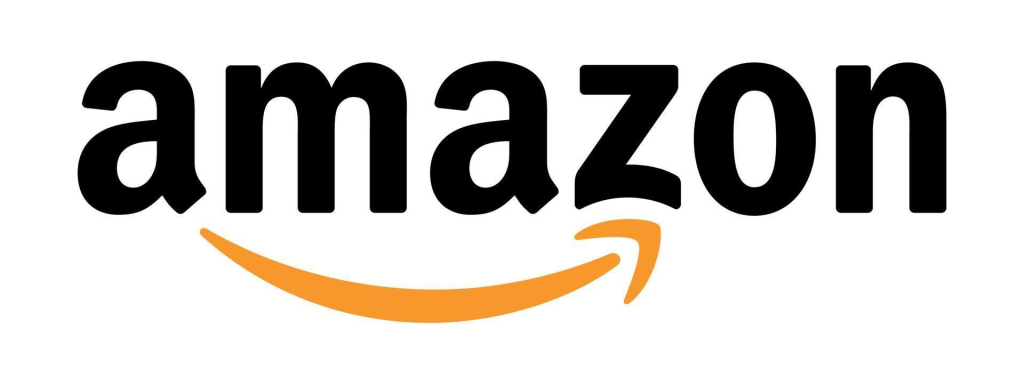
Amazon’s Project Amelia represents an AI-based selling expert that provides sellers with immediate answers, personalized insights, and real-time data analysis. This helps streamline sales performance by offering knowledge-based responses to complex selling questions, comparative traffic analysis, and automated problem resolution. It learns each seller’s unique business to provide tailored support that directly impacts sales performance.
Amazon’s DSP Performance+ advertising solution demonstrates advanced AI-driven customer acquisition, leading to a 51% improvement in acquisition costs compared to legacy campaigns. The system combines first-party signals with Amazon’s exclusive shopping and entertainment insights. It feeds this data into machine learning models that score every bid opportunity in real-time by analyzing trillions of data points with hourly prediction updates.
This approach enables predictive lead scoring that identifies prospects with the highest customer lifetime value potential, which allows for proactive demand management.

